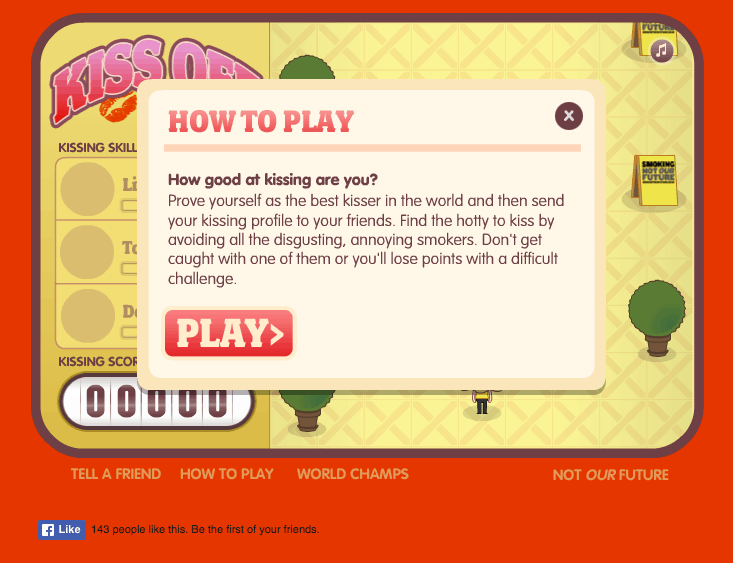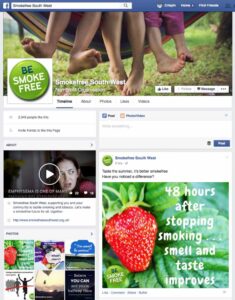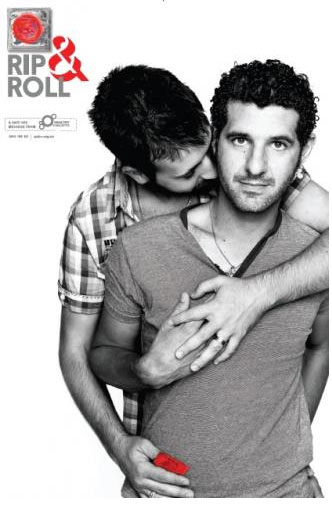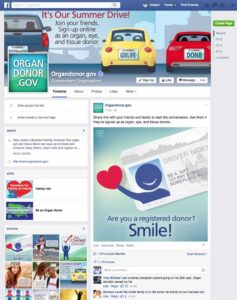How To Create A Public Health Campaign
Mantherapy, #loveyourcervix, #FKHIV. The best public health social media campaigns continually adapt to rolling, and unexpected, trends in social media usage.
Social media has gone from strength to strength in terms of user numbers. Current statistics show that 2271 million people use Facebook, 326 million Twitter, 1000 million Instagram and 287 million use Snapchat. As a result, public health campaigns increasingly compete for people's attention and seek to influence their behaviour through these social media channels. But this requires continually adapting to trends.
Indeed, Edison Research and Triton Digital's report, The Infinite Dial 2018, an annual research series on how we use social media, podcasts, and online audio services, argued that the year 2018 might have been "the year that social media changed forever." Detailing unexpected trends in social media usage, it adds: "In a complex and conflicted world, the relative escapism offered by thumbing through photos on Instagram, or creating the ultimate wish list on Pinterest, may be a welcome respite from the snark of Twitter or the sales pitches on LinkedIn."
While not limited to, recent trends that have impacted public health social media campaigns include:
- Short video and live streaming , with all the main channels competing for your eyeballs and scrolling time by pushing video and live content, prioritising it over many other types of posts.
- Facebook advertising has grabbed the headlines with its Orwellian micro-targeting ability!
- Instagram and Snapchat have certainly become the social media of choice for young people .
- The dominance of mobile with people seemingly addicted to scrolling and where photos and video are the 'opioid of choice'.
- Social messaging has also become one of the stars of the show, leading some people to say social messaging has taken over social media
Taking in the shifts in the ever-changing social media landscape, here are some of the best public health campaigns across the globe.
Best public health social media campaigns
Organ Donation Wales
Organ Donation Wales now have an excellent track record in encouraging people to talk more about the importance of organ donation. They also made the brave decision to hijack people's coffee orders in a very clever way of highlighting the problem caused by families overriding the wishes of their loved ones.
Matt Damon Surprises People with 'The Wait for Water'
In this example, Matt Damon does a great job bringing people's attention to the fact that women in the developing world have to wait up to six hours collecting water each day. Matt Damon and his foundation Water.org joined Stella Artois for "The Wait for Water," showing what happens when unsuspecting restaurant customers are told water won't be available for up to six hours.
#Loveyourcervix
Today we launch the #loveyourcervix campaign. Women that attend for cervical screening when they are first invited aged 25 are more likely to attend in the future, significantly reducing their risk of developing cervical cancer. #loveyourcervix pic.twitter.com/autBb2gFju
— Public Health Wales (@PublicHealthW) March 12, 2019
Another one from Public Health Wales who ran a #loveyourcervix campaign. They wanted to counter the embarrassment young women may have over the appearance of their vulva which is one of the main reasons young women give for not having cervical screening. The #loveyourcervix campaign aimed to promote body positivity and remind women "that smear takers have seen hundreds of vulvas!" Women that attend for cervical screening when they are first invited aged 25 are more likely to attend in the future, significantly reducing their risk of developing cervical cancer.
Man Therapy
This campaign from Colorado, in the USA, is aimed at men aged 24-54 who account for the most suicides. To encourage men to seek mental health help, the Colorado Office of Suicide Prevention and the Carson J Spencer Foundation wanted to counter the myth that strong men don't need to reach out for help. The campaign features a fictional character named Rich Mahogany, who provides "manly mental health tips" in humorous videos.
Sehat Ka Batua (The Health Purse)
Did you know that to protect their money women in rural India put their purse or "Batua" inside their blouses? Well, in this great example from India, Mahindra Rise partnered with Cancer Patients Aid Association to use this habit as a reminder to protect them from breast cancer. The last time we checked their Youtube video had been watched almost 750,000 times. This campaign was also shortlisted at Cannes Lion for Change 2018
#FCKHIV
MTV | #FCKHIV from Creative Awards on Vimeo.
On #WorldAidsDay MTV ran this campaign to encourage young people to get tested for HIV – they wanted to make this topic relevant again. Their clever campaign encouraged people to change the finger they usually get tested on and share it. They had 1.2 million impressions in 5 hours and became the number one trending topic in nine minutes! Even better Tested was the most used word on the day.
#HereForYou – Instagram
Mental health has become a popular topic for social media campaigns, as more and more people want to get involved in tackling the stigma associated with talking about mental health. In this popular example a one-minute campaign video featured three Instagram users talking about their past struggles with eating disorders, depression and suicidal thoughts. The campaign used its flagship hashtag #HereForYou for the campaign – one that was already commonly used by Instagram users.
UOKM8

LADbible Group – UOKM8? Case Study
Sticking with mental health, this three month campaign from TheLADBible Group called UOKM8 was aimed at raising awareness of mental health issues among men. It was inspired by the fact that suicide is the biggest killer of British men under 45. By partnering up with other a range of charities the campaign reached over 38 million young people and drove 823k engagements.
NICE turns to Snapchat
In 2017 the National Institute for Health and Care Excellence allegedly became the first major public health body to adopt Snapchat, in a bid to connect with young people. NICE's communications team shared several 'snap facts' throughout the day – using pictures and emojis – to explain how easily infections are spread and how quickly drug resistance develops. Others have followed, like Public Health England's campaign which used Snapchat Filters and Promoted Stories to encourage young people to use condoms and Leeds NHS mental health campaign which also used Snapchat filters. We expect to see more and more examples of health campaigns using Snapchat to reach its younger audience.
World Water Day
According to the United Nations, billions of people are still living without safe water – their households, schools, workplaces, farms and factories struggling to survive and thrive. In this example, World Water Day 2019 used a whole range of social media channels to encourage people to promote the fact that access to safe water is a human right. It underpins public health and is critical to sustainable development and a stable and prosperous world. The campaign organisers provided a range of social media resources to help people get involved and challenge the status quo in global society, where so many people are living without safe water. This included sharable materials like videos, animations and collection of cards and guides.
Lessons from corporate and social change sectors
In 2015, four authors from the Sydney School of Public Health and Cancer Council NSW published a detailed study on the lessons the public health sector could draw from nine public health social media campaigns by the corporate and the social change sector.
As the authors note, while there is a great deal of enthusiasm and interest in using social media for public health communications, "few research studies have examined its success in promoting and adopting protective health behaviours". Their study aimed to address this gap by taking a close look at the social media campaigns of three corporates – IKEA, Cadbury, and Smirnoff – and six social change organisations – Burnett Institute, World Lung Foundation, the New Zealand health Sponsorship Council, Smokefree South West UK, the Queensland Association of Health Communities, and the New York Alliance for Donation.
While not all of the health-related campaigns remain online, outlined below are some of the campaigns that incorporated findings into the planning and delivery of effective public health social media campaigns.
Burnett Institute FaceSpace
The Burnett Institute's sexual health campaign, FaceSpace, features on the project's YouTube channel, Being Brendo. It is part of a series of short films about a variety of health issues that confront gay men. (Please note, there is a language warning on this. It may not be suitable for office viewing.)
The Burnett Institute established the FaceSpace project to examine whether social networking sites could be used successfully to deliver health promotion messages:
During 2009 and 2010, we implemented a novel health promotion intervention using social networking sites – "The FaceSpace Project". This pilot intervention trialled the delivery of sexual health promotion via social networking sites to two key at-risk groups: young people aged 16-29 years, and men who have sex with men (MSM).
The project concept was to use fictional characters to interact and post content (primarily videos) on various social networking sites, with sexual health promotion messages embedded within some of these postings. The young people's arm was developed and implemented first, with learning's from this arm applied to the development of the MSM arm.
FaceSpace is a great example of using humor, narrative and character as part of a successful social media for public health campaign.
World Lung Foundation PackHead
The World Lung Foundation released an application on Facebook that allowed users to add rotten teeth, throat tumors, bleeding brains and other smoking-related illnesses to their profile pictures or pictures of friends. Users placed the altered images on a generic pack of cigarettes and shared them. The application, named PackHead, was intended to raise awareness and support for graphic package warnings, which are more effective at communicating the harms of smoking than standard text.
Smoke-Free Alexandria
The Egyptian Ministry of Health, in coordination with World Lung Foundation, launched a two-stage "Smoke-Free Alexandria" media campaign, stretching a small campaign budget by using innovative tactics to attract additional media interest and attention.
In order to avoid expensive Ramadan-priced mainstream media, they launched perhaps Egypt's first Facebook ad campaign for public health. The campaign, starting at the beginning of smoke-free legislation enforcement and messaged to publicise the high level of public support for the law, saw wide coverage in newspapers and online media.
The advertisements achieved an astonishing 11.5 million impressions and more than 5,000 "friends" in under ten days—all for a cost of only USD$3,500.
Chew On This
The Ministry of Health & Family Welfare's (MOHFW) Tobacco Control Programme launched a nationwide television, radio and YouTube campaign called "Surgeon." The campaign featured cancer patients at Tata Memorial Cancer Hospital's neck and throat cancer ward and highlighted the devastating consequences of smokeless tobacco to warn against its use. The campaign was produced in association with World Lung Foundation (WLF) and the Bloomberg Initiative to reduce Tobacco use.
The campaign video shows cancer surgeon Dr. Prashant Pawar as he conducts his rounds in one of the busiest head, neck and throat cancer wards in the world. The viewer sees the horrifying effects of mouth cancers caused by chewing tobacco as the surgeon consults with his patients – some as young as 18-years-old.
New Zealand Health Sponsorship Council Online Anti-Smoking Games
The New Zealand Health Sponsorship Council created a series of online games targeted at younger children to discourage the uptake of smoking. The games were distributed for free via a number of online gaming sites. These included:
KissOff

Butthead Bash

Along similar lines is Interactive Biopsy. Another great interactive feature, this from OxyGen in Australia, that lets you play doctor with a tobacco victim. Use a scalpel, syringe or tweezers to take body samples and see why this tobacco user may have died. This is definitely for older kids and inappropriate for elementary school-aged children.

These types of games fall into a category of educational games called "serious games".
Smokefree South West UK Be Smoke-Free
Smokefree South West was commissioned by eleven public health teams based in local authorities across the south-west of England. The project aimed to deliver an evidence-based programme to create a smoke-free future for children by making tobacco use less desirable and accessible as well as accelerating a reduction in the smoking rate across the region.
Smokefree South West runs a wide range of campaigns to encourage individuals to quit smoking but also influence public policy by encouraging local authorities to adopt smoke-free homes, hospitals, and public area policies.
Smokefree South West makes great use of all social media channels including Facebook and Twitter.

Smokefree South West UK – Be Smoke Free Facebook Page
Queensland Association of Health Communities Rip & Roll
The Queensland AIDS Council (QuAC) is an independent community-based health promotion charity. QuAC was formed in 1984 by a group of largely gay men in response to the HIV/AIDS epidemic in Queensland. From that time the Queensland AIDS Council grew to deliver HIV prevention programs, client services for people with HIV, peer support through Queensland Positive People and we provided a strong voice on HIV and gay issues.

Queensland Association of Health Communities Rip & Roll
In 2011, QuAC launched a series of bus shelter billboard safe sex advertisements targeting gay men. Adshell, the company that managed the bus shelters advertisements received a number of complaints about the ads and decided to take them down. There was a subsequent "anti-homophobia" campaign (and Facebook page) that developed significantly more publicity than the original campaign.
The ads were the most complained about advertisements of the year! They were, nevertheless, reinstated and the campaign was extended through the creation of a YouTube channel and a series of "the making of" style videos about the Rip & Roll campaign.
In the words of QuAC:
Men4Men's HIV prevention and sexual health education in traditional and social media was significant. Campaigning in the variety of media formats contained advertisements as well as sexual health articles with a focus on the core issues of this program – condom reinforcement and risk reduction strategies; the lived experience of HIV; and HIV and STI testing.
Rip & Roll (two and three) focusing on the importance of condoms and lube appeared at the start of this year and its further development occurred towards the close of 2011-2012. Following the publicity boost from the unwarranted controversy of two men hugging, Junior our advertising and communications company, created four short YouTube clips using the history of the campaign to promote the importance of condom reinforcement.
Six new poster executions were created for LGBT settings and outdoor advertising again. These outdoor advertising opportunities are the shared, mainstream spaces were gay men spend much of their time. The Rip & Roll campaign was, and will be, seen this year at bus stops and billboards across Queensland.
New York Alliance for Donation Organ Donor
The mission of the New York Alliance for Donation is to increase organ, eye and tissue donation in New York State through collaborative advocacy, education, promotion, and research. Their goal is to ensure a transplant for every New Yorker in need.
Every year, more than 1,500 people receive kidneys, livers, and hearts that have been donated for transplantation. However, with more than 10,000 New Yorkers still on waiting lists, the need for organ donations far exceeds the supply. One person who donates organs (hearts, lungs, liver, kidneys, pancreas and intestine) can save up to eight lives, while tissue donors (corneas, bone, skin, heart valves, tendons, veins, etc.) can improve 12 or more lives by restoring eyesight, helping fight infections in burn patients and prevent the loss of mobility and disability.
This animated video explains the transplant waiting list, how someone becomes a donor, the process of matching organs, and signing up to share the gift of life. They also have Facebook and Twitter channels to reach out into the community.

OrganDonor.Gov Facebook Page
All of these terrific health campaigns show the scope of public health social media campaigns that engage people and have the potential to bring about health awareness, education and change.

How To Create A Public Health Campaign
Source: https://www.bangthetable.com/blog/public-health-social-media-campaigns/
Posted by: whitesidewheark.blogspot.com

0 Response to "How To Create A Public Health Campaign"
Post a Comment